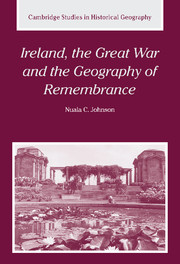Book contents
- Frontmatter
- Contents
- List of illustrations
- Acknowledgements
- 1 Geography, landscape and memory
- 2 A call to arms: recruitment poster and propaganda
- 3 Parading memory: peace day celebrations
- 4 Sculpting memory: space, memorials and rituals of remembrance
- 5 Scripting memory: literary landscapes and the war experience
- 6 Remembering the Easter Rebellion 1916
- 7 Conclusion
- Bibliography
- Index
- Cambridge Studies in Historical Geography
1 - Geography, landscape and memory
Published online by Cambridge University Press: 15 July 2009
- Frontmatter
- Contents
- List of illustrations
- Acknowledgements
- 1 Geography, landscape and memory
- 2 A call to arms: recruitment poster and propaganda
- 3 Parading memory: peace day celebrations
- 4 Sculpting memory: space, memorials and rituals of remembrance
- 5 Scripting memory: literary landscapes and the war experience
- 6 Remembering the Easter Rebellion 1916
- 7 Conclusion
- Bibliography
- Index
- Cambridge Studies in Historical Geography
Summary
On a grey, wet Sunday in October 2001 the bodies of nine men executed and buried in Mountjoy gaol in Dublin were exhumed and reinterred at Glasnevin cemetery. Thousands of people lined the streets of Dublin to watch the passing of the funeral cortege, while tens of thousands witnessed the event as it was broadcast live on the national television network. With full state honours, the coffins, draped in the Irish tricolour, were publicly paraded from the gaol to the Catholic Pro-Cathedral in central Dublin where a concelebrated requiem mass was held before the bodies were transported for burial to Glasnevin cemetery. A graveside oration, delivered by the Irish Taoiseach (Prime Minister), was accompanied by the sounding of three rounds of ammunition and the playing of the Last Post and national anthem. While some controversy surrounded the day's events, by and large the ceremony was deemed a fitting, dignified and noble occasion of reconciliation and remembrance. The men concerned were Irish Republican Army (IRA) Volunteers executed eighty years earlier, under British authority, at Mountjoy gaol during the War of Independence 1920–21. Their bodies had been buried in the grounds of the prison and their re-interring at Glasnevin cemetery had been mooted over subsequent decades. The final symbolic recognition of their sacrifice through the performance of a state funeral on a rainy autumnal day in 2001 reinforces the significance of the dead in the arousal of the collective and personal memories of the living.
- Type
- Chapter
- Information
- Publisher: Cambridge University PressPrint publication year: 2003



